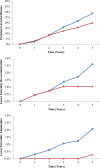Favorable effects of insulin sensitizers pertinent to peripheral arterial disease in type 2 diabetes: results from the Bypass Angioplasty Revascularization Investigation 2 Diabetes (BARI 2D) trial
- PMID: 23735723
- PMCID: PMC3781574
- DOI: 10.2337/dc12-2265
Favorable effects of insulin sensitizers pertinent to peripheral arterial disease in type 2 diabetes: results from the Bypass Angioplasty Revascularization Investigation 2 Diabetes (BARI 2D) trial
Abstract
Objective: The aim of this manuscript was to report the risk of incident peripheral arterial disease (PAD) in a large randomized clinical trial that enrolled participants with stable coronary artery disease and type 2 diabetes and compare the risk between assigned treatment arms.
Research design and methods: The Bypass Angioplasty Revascularization Investigation 2 Diabetes (BARI 2D) trial randomly assigned participants to insulin sensitization (IS) therapy versus insulin-providing (IP) therapy for glycemic control. Results showed similar 5-year mortality in the two glycemic treatment arms. In secondary analyses reported here, we examine the effects of treatment assignment on the incidence of PAD. A total of 1,479 BARI 2D participants with normal ankle-brachial index (ABI) (0.91-1.30) were eligible for analysis. The following PAD-related outcomes are evaluated in this article: new low ABI≤0.9, a lower-extremity revascularization, lower-extremity amputation, and a composite of the three outcomes.
Results: During an average 4.6 years of follow-up, 303 participants experienced one or more of the outcomes listed above. Incidence of the composite outcome was significantly lower among participants assigned to IS therapy than those assigned to IP therapy (16.9 vs. 24.1%; P<0.001). The difference was significant in time-to-event analysis (hazard ratio 0.66 [95% CI 0.51-0.83], P<0.001) and remained significant after adjustment for in-trial HbA1c (0.76 [0.59-0.96], P=0.02).
Conclusions: In participants with type 2 diabetes who are free from PAD, a glycemic control strategy of insulin sensitization may be the preferred therapeutic strategy to reduce the incidence of PAD and subsequent outcomes.
Trial registration: ClinicalTrials.gov NCT00006305.
Figures
References
-
- Selvin E, Erlinger TP. Prevalence of and risk factors for peripheral arterial disease in the United States: results from the National Health and Nutrition Examination Survey, 1999-2000. Circulation 2004;110:738–743 - PubMed
-
- Allison MA, Ho E, Denenberg JO, et al. Ethnic-specific prevalence of peripheral arterial disease in the United States. Am J Prev Med 2007;32:328–333 - PubMed
-
- Criqui MH, Langer RD, Fronek A, et al. Mortality over a period of 10 years in patients with peripheral arterial disease. N Engl J Med 1992;326:381–386 - PubMed
-
- Newman AB, Sutton-Tyrrell K, Vogt MT, Kuller LH. Morbidity and mortality in hypertensive adults with a low ankle/arm blood pressure index. JAMA 1993;270:487–489 - PubMed
-
- O’Hare AM, Katz R, Shlipak MG, Cushman M, Newman AB. Mortality and cardiovascular risk across the ankle-arm index spectrum: results from the Cardiovascular Health Study. Circulation 2006;113:388–393 - PubMed
Publication types
MeSH terms
Substances
Associated data
Grants and funding
LinkOut - more resources
Full Text Sources
Other Literature Sources
Medical



